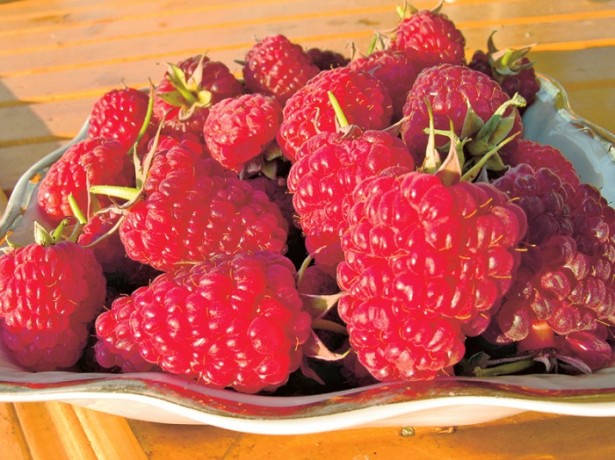Grade Monomakh's cap - a new remontant type of raspberry. There are a lot of rumors and questions around him, not every gardener is in a hurry to select a site for his planting.
Table of contents
Favorable breeding areas
Raspberry Variety The Monomakh's Cap is bred by the leading fruit breeder Ivan Vasilievich Kazakov.
Moscow and the Moscow region are favorable areas for growing this raspberry variety. The plant tolerates winter with stamina, without requiring special warming.
In central Russia, raspberries of this variety are recommended to be planted in the first half of October. In the southern regions, the period varies from the beginning of October to the first decade of November.
In the regions of Siberia and the Urals, after the end of frosts, the main insulation in the form of leaves, snow is removed and Cover plants with black film. This will accelerate the process of growth and strengthening of young stems.
Like any cultivated crops, remontant raspberry. The monomakh's cap has its pros and cons. The positive qualities of raspberries are:
- High yield.
- Frost resistance.
- Large and tasty berries.
- Pest resistance.
The main the minus of the variety is susceptibility to viral diseases. It is necessary to figure out whether it is good for growing.
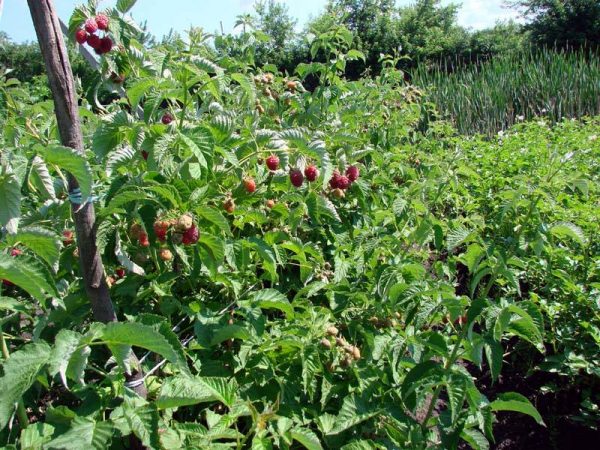
Appearance
Now let's talk about the description of raspberries. Thick shoots of green, towering above the ground by 1, 5 meters, strongly branched.The branches of a formed bush wilt down, and it resembles a small tree.
Berries
The Monomakh's Cap is famous for its large tasty berries of bright red color. The shape of the berries is elongated, conical with a rather blunt end. On average, the mass of the berry reaches almost 7 gr., In some cases the weight reaches 20 gr., And the berries are the size of a plum. The size of the raspberry is directly proportional to watering.: if the soil is well moistened, the berries are large, juicy, and the lack of moisture leads to a decrease in the size and number of fruits.
The juicy flesh is easily separated from the stem, sweet and slightly sour, it melts in the mouth, leaving a pleasant aftertaste. Berry has an elastic texture, so it can be transported over short distances and stored. It is consumed fresh as a dessert, good for making jam, stewed fruit, fruit drinks.
Yield
The yield of the bush depends on the conditions of maintenance and care, for the season with one bush can be collected 4.5 - 5 kg of berries. If the berries are large, as a rule, this happens in the first two years, then you can collect up to 8 kg of raspberries.
The bushes of this variety begin to bear fruit in the second half of August and continue until mid-autumn, right up to the first frost. Berries have enough time to form and ripen.Over the entire period, you can collect about 60% of the declared harvest, the rest of the time does not have time to pick up color before the onset of cold weather.
It is easy to remove fruits from a bush - this grade is deprived of prickles. Only a small number of thorns are located at the base of the bush.
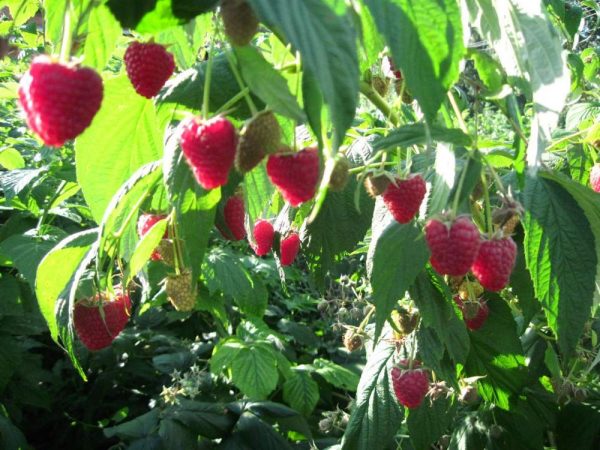
Features of planting and growing
The cap of the monomakh is remontantny grade. Its advantage over other raspberry species is that it bears fruit 2 times a year. Cultivating the variety has affected the quality and quantity of the crop harvested in the second phase of fruiting.
It begins in mid-August and continues until frost and differs from the first decrease in pests and viral diseases of the bush.
In addition, you may be interested in other raspberry varieties:
For planting raspberries prepare trenches:
- excavated to a depth of 35-40 cm;
- fertilize with humus;
- Pour mineral fertilizer, diluted to the desired concentration.
Seedlings need to be placed at 75 - 80 cm from each other, sprinkle with a small amount of earth and rammed. Bury cuttings should not be deep, the roots should be located close to the surface. After planting the plants need to be watered with stimulants for better and fast root growth.. You can find them in any specialty store.
Next, you need to make mulch from humus or plant residues.
Care of a grade of a repair raspberry Monomakh's Cap
Repair raspberry variety requires careful maintenance:
- When planting and throughout life, the bush must be fertilized with mineral fertilizers and humus.
- To monitor the soil moisture, the drying of the soil is unacceptable.
- Loosening is a prerequisite for leaving; excess water can cause root rot.
- One square meter should be no more than 5 - 6 plants.
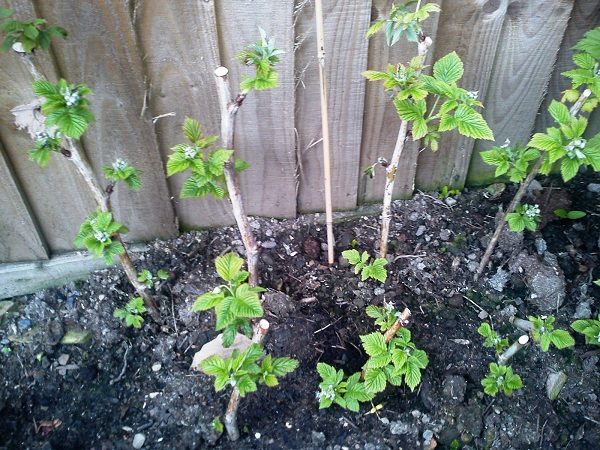
If during planting the seedling received a sufficient amount of fertilizer, then in the first year additional feeding is not required. In subsequent years, fertilizers are applied in stages:
- Nitrogen supplements are relevant in the spring,which intensify the intensive growth and weight gain of the leaves;
- during ripening - rich in potassium and phosphorus, to improve the quality of the crop;
- when preparing for winter, organic matter is introduced, in most cases high-quality humus, fresh manure is eliminated.
Preparing for winter is also a kind of ritual:
- We collect the remaining berries
- Use pruners or large scissors to cut all branches and shoots flush with the ground.
- Loosen the ground gently around the roots, where possible, with a thin knife or a special spatula.
- Top poured a thin layer of humus and ash.
If you do not want to cut off the shoots, but you want to harvest 2 times, raspberries need to be warmed by mulching, and also sprinkled with fallen leaves or mowed grass. Pruning of stems is carried out according to a different scheme. It is necessarily held in spring and autumn, the branches are cut off:
- sick;
- thin and underdeveloped;
- broken;
- two year old dead.
For the vegetation to get enough sunlight it is necessary to build a structure to hold the stems in a vertical position. To do this, around the landing break the stakes between which they stretch the wire, which serves as a kind of support. Stalks are neatly tied to it, trying not to injure the surface layer.
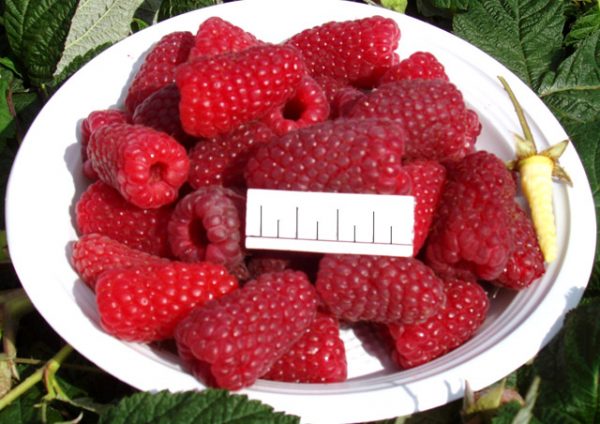
Breeding
Reproduction of the raspberry variety The monomakh's cap is made difficult by the traditional method, because the bottom raspberry does not overgrow with thick overgrowth and reproduces using green cuttings grown specifically for breeding. To do this, in early spring, young shoots are carefully separated from the main bush:
- remove the top layer near the base by 2 - 2.5 cm.
- cut off the green shoot as close as possible to the root system.
The root should not be damaged. Use sharp objects for work to minimize the risk of injury to the plant.
- rooted in a pot of peat and placed in greenhouse conditions.
After a few weeks, a bud appears at the base of the shoot, which gives an impetus to the growth of the seedling. In the second half of May or at the beginning of June, he is ready for transplantation to a permanent place of growth.
The choice of site for landing
Resistance to infections and pests, as well as increased yields depend on the place of permanent residence of this litter. For the Monomakh Cap view, the following sections will fit:
- fertile;
- PH is neutral;
- sunny, on the south side;
- well drained.
Swampy soils with high acidity are not suitable for cultivation, as well as close groundwater. This variety requires high quality soil due to the peculiarities of the root system. The main part of the roots is located close to the surface, so the soil layer here must be constantly moist, loose and allow the maximum amount of air to pass through.
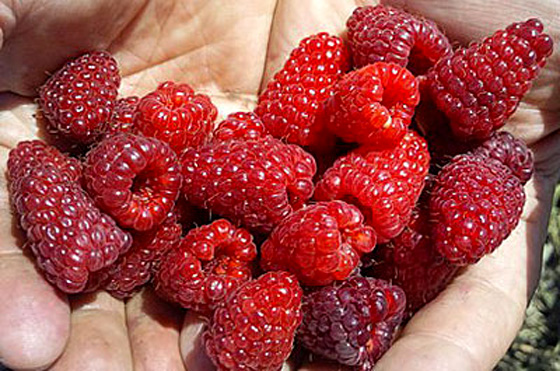
Due to the capriciousness of the variety, it is necessary to test the soil for the presence of acid before planting. To do this, you can use a proven easy way:
- Take 5 leaves of black currant and pour 200 ml. boiling water (1 cup).
- Let it sit for 10 - 15 minutes and remove the sheets.
- To lower a small amount of soil into the broth from the spot for planting.
- Wait for the appearance of the shade:
- red - acidic soil;
- green - slightly acidic soil;
- blue - neutral PH.
If the soil is acidic, and you simply cannot find another place, you can neutralize the high acidity. To do this, for each square meter of the site is 400 - 500 grams. lime flour, if the soil is slightly acidic, the dosage is halved.
Wood ash is perfect for this purpose (the owners can boast of its presence with a bath in the garden plot), besides the main effect, it will saturate the soil with useful microelements such as potassium, phosphorus, calcium, magnesium and others.
Diseases and pests
As mentioned above, the raspberry varieties of the Monomakh's Cap, due to the specifics of pruning, are little affected by pests. But young shoots are not insured against viral infections spread by flying, sucking insects, such as aphids and cicadas. They can spread the disease from infected plants. The most common ones are:
- Viral chlorosis. The main symptoms of the disease: yellowing dry leaves, reducing the size of the shoots.Berries with chlorosis undeveloped, do not have time to ripen and dry.
- Yellow mosaic is characterized by yellowed leaves with twisted dry edges. The berry does not dry out completely, but develops one-sidedly and has an unleavened taste.
- Kinkiness is defined about the following features:
- stunting;
- increase in size in diameter;
- brown shade of leaves;
- leaf size reduction;
- drying berries.
The fight against viruses is pruning sick shoots as needed. For prophylactic purposes, plants are treated in early spring with fungicidal preparations, including Bordeaux mixture. Insectofungicides sold in specialized stores, it is necessary to spray the still dormant buds, and repeat the treatment before and after flowering.
Gardeners reviews
Margarita Petrova: I ordered several types of repair raspberries in spring: Hercules' Daughter, Golden Autumn, Monomakh's Cap. The first two began to dry out immediately, I was upset about the money spent. But "Monomakh's Cap" was pleasantly surprised. Not only did the bushes burst with berries, so there was little overgrown around the bush, it was not difficult to remove it.
Gleb Viktorovich: I live in Siberia.The year before last, he planted a hat, but he didn’t manage to collect half of the fruit, it was cold. So for lovers in Siberia is not suitable. For those who know all the subtleties of growing and insulation, and may be suitable. The only advantage of this whole story is very tasty berries.
Oksana Ivanova: They advised the repair raspberry, not really understanding what this saplings ordered, came the Monomakh's Cap. Yes, large and tasty fruits, but until you wait for them. I want to eat raspberry already in early summer.
